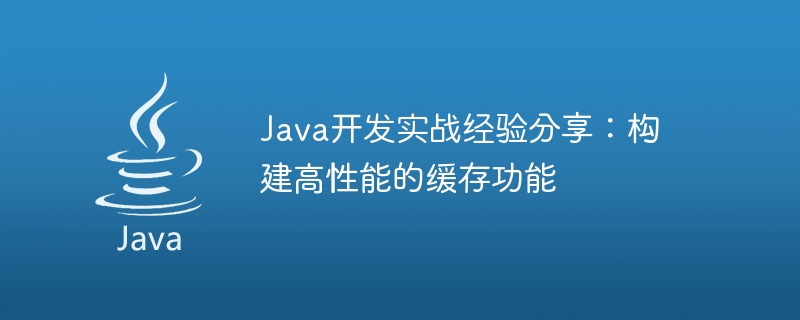

With the continuous development of Internet business and the gradual increase in data volume, caching functions have increasingly become an indispensable part of applications. Especially in distributed application scenarios, caching has become the preferred solution to solve high concurrency and large traffic problems. In the field of Java development, the implementation of cache functions requires high performance, high availability and high scalability. Therefore, how to build a high-performance cache function has become an important issue that Java development engineers need to pay attention to. In this article, we will share some practical experience in Java development to help you build high-performance caching functions.
1. What is cache
Before introducing how to build a high-performance cache function, we need to first understand what cache is. Caching is a technology that stores data in high-speed memory to speed up data access and improve system performance.
Normally, application data is stored in a database or file system. Every time you need to access data, you need to obtain the data through the network or file system, which will cause the system to respond. Slows down. By storing hotspot data in the cache, applications can obtain data from the cache instead of obtaining data from the database or file system, thereby improving the system's response speed.
2. How to build a high-performance caching function
1. Choose an appropriate caching solution
In Java development, we can choose a variety of different caching solutions, such as Local cache, distributed cache, in-memory database, etc. When choosing a caching solution, you need to consider the actual business usage scenarios and the performance indicators that need to be achieved, and select an appropriate caching solution.
2. Optimize cache access
Storing data into the cache is only part of the cache function. In order to achieve high-performance caching function, cache access also needs to be optimized. For example, the LRU (Least Recently Used) cache eviction algorithm can be used to clear the least recently used data from the cache to free up more space to store new data. In addition, cache preheating can also be used to load some hot data into the cache when the application starts to improve the cache hit rate.
3. Choose the appropriate caching framework
In Java development, there are many caching frameworks to choose from, such as Ehcache, Redis, Memcached, etc. Each framework has its advantages and disadvantages, and you need to choose the appropriate framework according to the actual situation. For example, Ehcache is suitable for local caching and can be easily integrated into applications; while Redis and Memcached are suitable for distributed caching and can support multiple machines to share cached data.
4. Use cache annotations
In Java development, cache annotations can be used to implement the cache function. For example, using the @Cacheable annotation to annotate a method indicates that the return value of the method needs to be cached. The next time the method is called, the data can be obtained directly from the cache without recalculation. In addition, you can also use the @CacheEvict annotation to annotate methods, indicating that the cache data needs to be cleared after the method is executed.
5. Implement automatic cache update
Cache automatic update is an advanced cache function that can make the data in the cache consistent with the underlying data source. To achieve automatic cache update, you need to use the "cache message queue" method. When the underlying data source changes, a message will be sent to the message queue. The cache service will listen to the message queue and update the data in the cache once the message is received.
3. Summary and Outlook
The caching function is an indispensable part of Java development. Building high-performance caching functions requires developers to have certain technical and practical experience. They need to choose appropriate caching solutions, optimize cache access, select appropriate caching frameworks, use cache annotations, implement automatic cache updates, etc. With the continuous development of technology, caching functions are also constantly changing and improving. The future development direction will be more intelligent, automated, high-availability and high-performance caching functions.
The above is the detailed content of Java development practical experience sharing: building high-performance caching function. For more information, please follow other related articles on the PHP Chinese website!




